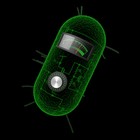Breakthroughs in Bio-Computing
It’s now clear that the next generation of software and hardware developers will need to master both life sciences and computer science. Why? Because the two fields are increasingly becoming intertwined. This week, MIT announced:
“MIT engineers have transformed bacterial cells into living calculators that can compute logarithms, divide, and take square roots, using three or fewer genetic parts. Inspired by how analog electronic circuits function, the researchers created synthetic computation circuits by combining existing genetic ‘parts,’ or engineered genes, in novel ways.
The circuits perform those calculations in an analog fashion by exploiting natural biochemical functions that are already present in the cell rather than by reinventing them with digital logic, thus making them more efficient than the digital circuits pursued by most synthetic biologists, according to Rahul Sarpeshkar and Timothy Lu, the two senior authors on the paper, describing the circuits in the May 15 online edition of Nature. The lead author of the Nature paper is MIT postdoc Ramiz Daniel. Jacob R. Rubens, a graduate student in microbiology, is also an author of the paper.”
Although the main rationale for having bacteria act as calculators is presumably for bio-medical applications, my presumption is that cellular computing may eventually replace many forms of traditional computing. The cellular-based analog sensing and computation described in this MIT research can be combined with digital circuitry to perform actions.
This is not a new idea. But it is a profound transformational innovation that’s occurring within our lifetimes. That’s pretty exciting!
“‘We have just scratched the surface of what sophisticated analog feedback circuits can do in living cells,’ says Rahul Sarpeshkar, whose lab is working on building further new analog circuits in cells. He believes the new approach of what he terms ‘analog synthetic biology’ will create a new set of fundamental and applied circuits that can dramatically improve the fine control of gene expression, molecular sensing, computation and actuation.”
Scott Jordan, one of Patty’s Pioneers, flagged this discovery for us. Others in this group of high tech architects and entrepreneurs commented enthusiastically:
“That is awesome: The machine inside the machine, inside the machine”
“Why, soon our computers won't just have bugs, they'll BE bugs...”
“Doubling has shortened perceptively. We are inside the next era.”
Harnessing Bacteria as Analog Sensors and Calculators and DNA for Data Storage. This breakthrough in mapping electrical engineering frameworks into synthetic biology reminded me of another recent discovery of digital to analog biology that also hit the mainstream media: the ability to use DNA to store lots of data efficiently for a long-time. Nick Goldman and Ewan Birney, from the European Bioinformatics Institute came up with the idea of storing huge amounts of data in synthetic DNA in a pub. They recruited colleagues, implemented the idea using Shakespeare’s sonnets, and got a write-up in the Economist, titled “Test-tube Data.”
Their research was also published in Nature in a paper entitled: “Towards practical, high-capacity, low-maintenance information storage in synthesized DNA.” In the abstract to the paper, the authors wrote:
“Theoretical analysis indicates that our DNA-based storage scheme could be scaled far beyond current global information volumes and offers a realistic technology for large-scale, long-term and infrequently accessed digital archiving.”
We’ll definitely be keeping an eye on this increasing convergence between electronic computing and synthetic biology. It’s clearly the next era in computing and will not only transform medicine and life sciences, but many of the ways in which we currently harness digital technology.
0 comments
Be the first one to comment.



